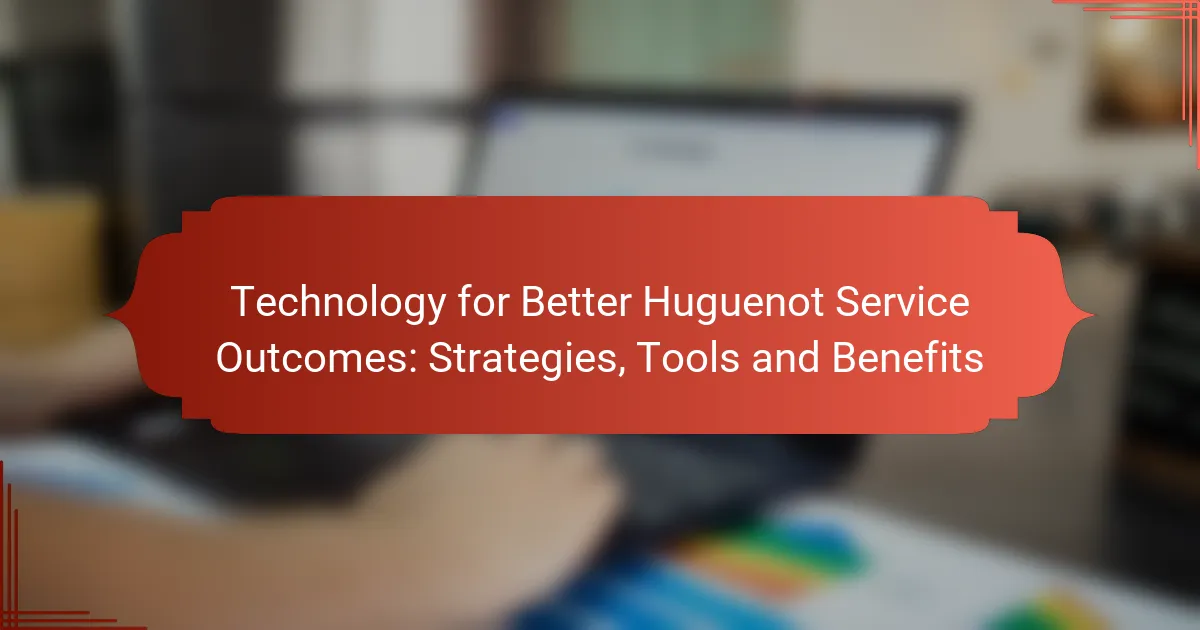Incorporating advanced technologies such as telehealth platforms, data analytics tools, and AI-driven chatbots can greatly improve Huguenot service outcomes in Ireland. These innovations streamline communication, enhance data management, and increase service accessibility, ultimately leading to better health outcomes and patient satisfaction. By leveraging these tools, organizations can make informed decisions that optimize resource utilization and address customer needs effectively.
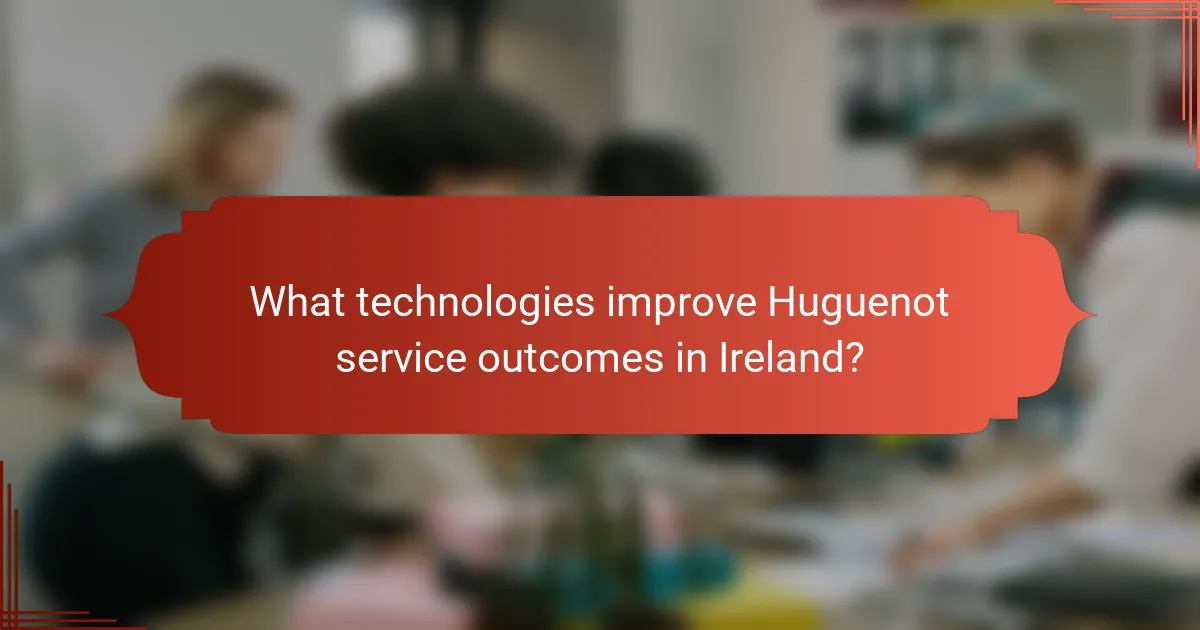
What technologies improve Huguenot service outcomes in Ireland?
Technologies such as telehealth platforms, data analytics tools, mobile applications, CRM systems, and AI-driven chatbots significantly enhance Huguenot service outcomes in Ireland by streamlining communication, improving data management, and increasing accessibility to services.
Telehealth platforms
Telehealth platforms facilitate remote consultations, allowing Huguenots to access healthcare services without the need for travel. These platforms often include video conferencing, secure messaging, and electronic health records, making it easier for service providers to deliver care efficiently.
When selecting a telehealth solution, consider factors such as user-friendliness, compliance with local regulations, and integration capabilities with existing systems. Popular options in Ireland include Healthlink and MyConsult.
Data analytics tools
Data analytics tools enable Huguenot service providers to analyze trends and outcomes effectively. By leveraging data, organizations can identify areas for improvement, optimize resource allocation, and enhance service delivery.
Implementing data analytics requires a clear strategy, including defining key performance indicators (KPIs) and ensuring data quality. Tools like Tableau and Microsoft Power BI can help visualize data for better decision-making.
Mobile applications
Mobile applications enhance accessibility to Huguenot services by providing users with information and resources at their fingertips. These apps can offer features such as appointment scheduling, reminders, and educational materials tailored to the Huguenot community.
When developing or choosing a mobile app, prioritize user experience and ensure it is compatible with both iOS and Android devices. Engaging with the community during the design phase can lead to higher adoption rates.
CRM systems
Customer Relationship Management (CRM) systems help Huguenot organizations manage interactions with clients and streamline administrative processes. These systems can track service usage, manage communications, and improve follow-up care.
Choosing a CRM system should involve assessing features like customization options, ease of use, and integration with other technologies. Popular CRM solutions include Salesforce and HubSpot.
AI-driven chatbots
AI-driven chatbots can provide immediate assistance to Huguenots by answering common queries and directing users to appropriate resources. This technology enhances service efficiency and frees up staff to focus on more complex issues.
When implementing chatbots, ensure they are programmed with relevant information and can escalate issues to human representatives when necessary. Regular updates and training will keep the chatbot effective and aligned with user needs.

How can data analytics enhance service delivery?
Data analytics can significantly enhance service delivery by providing insights into performance metrics, customer needs, and operational efficiency. By analyzing data trends, organizations can make informed decisions that lead to improved outcomes and better resource utilization.
Identifying service gaps
Data analytics helps in pinpointing service gaps by analyzing customer feedback, service usage patterns, and performance metrics. For instance, if data reveals that a significant number of clients are dissatisfied with response times, this indicates a gap that needs addressing.
Utilizing tools like surveys and performance dashboards can provide a clearer picture of where services fall short. Regularly reviewing this data allows organizations to adapt their offerings to meet client expectations more effectively.
Improving resource allocation
Effective resource allocation is enhanced through data analytics by identifying which areas require more support and which are over-resourced. For example, if analytics show that certain services are underutilized, resources can be redirected to more in-demand areas.
Implementing predictive analytics can also forecast future service demands, allowing organizations to prepare accordingly. This proactive approach ensures that resources are allocated efficiently, minimizing waste and maximizing service effectiveness.
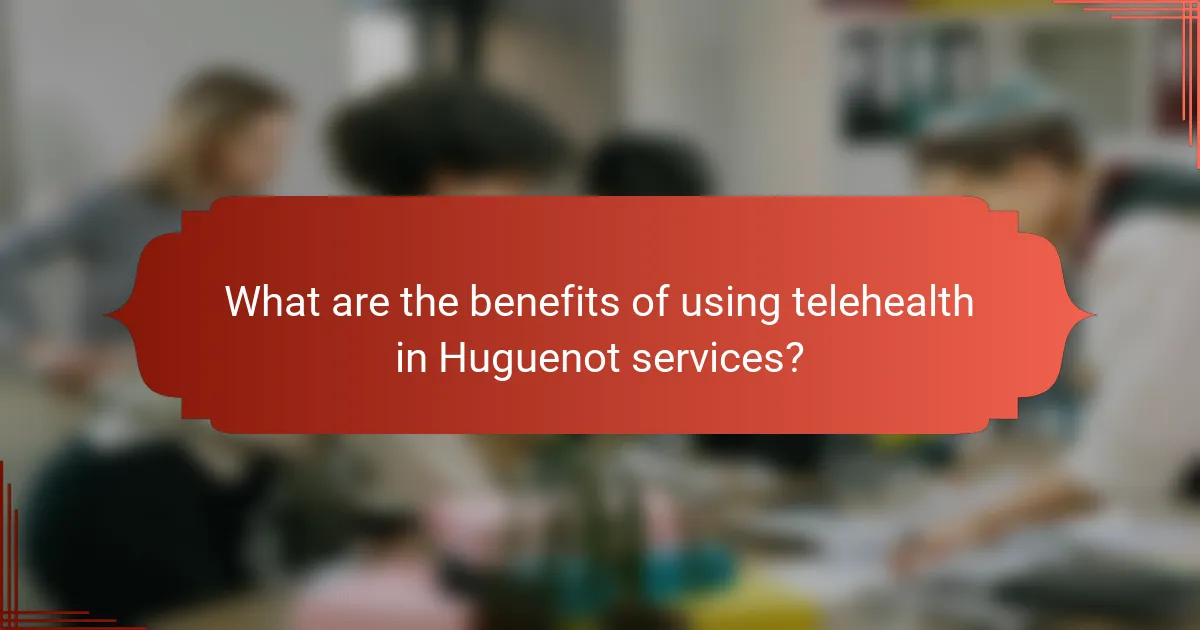
What are the benefits of using telehealth in Huguenot services?
Telehealth in Huguenot services offers significant advantages, including improved access to care and enhanced patient satisfaction. By leveraging technology, healthcare providers can deliver services more efficiently and effectively, ultimately leading to better health outcomes.
Increased accessibility
Telehealth significantly increases accessibility for patients in Huguenot services by allowing them to connect with healthcare providers from the comfort of their homes. This is particularly beneficial for individuals in rural areas or those with mobility challenges who may find it difficult to travel to a physical location.
Additionally, telehealth can accommodate various schedules, making it easier for patients to receive care without disrupting their daily routines. This flexibility can lead to higher engagement and adherence to treatment plans.
Reduced wait times
Using telehealth can lead to reduced wait times for patients seeking Huguenot services. Virtual consultations often have shorter scheduling periods compared to in-person visits, allowing patients to receive timely care when they need it most.
Moreover, telehealth can streamline the administrative process, minimizing delays associated with paperwork and check-ins. This efficiency not only benefits patients but also allows healthcare providers to manage their time and resources more effectively.
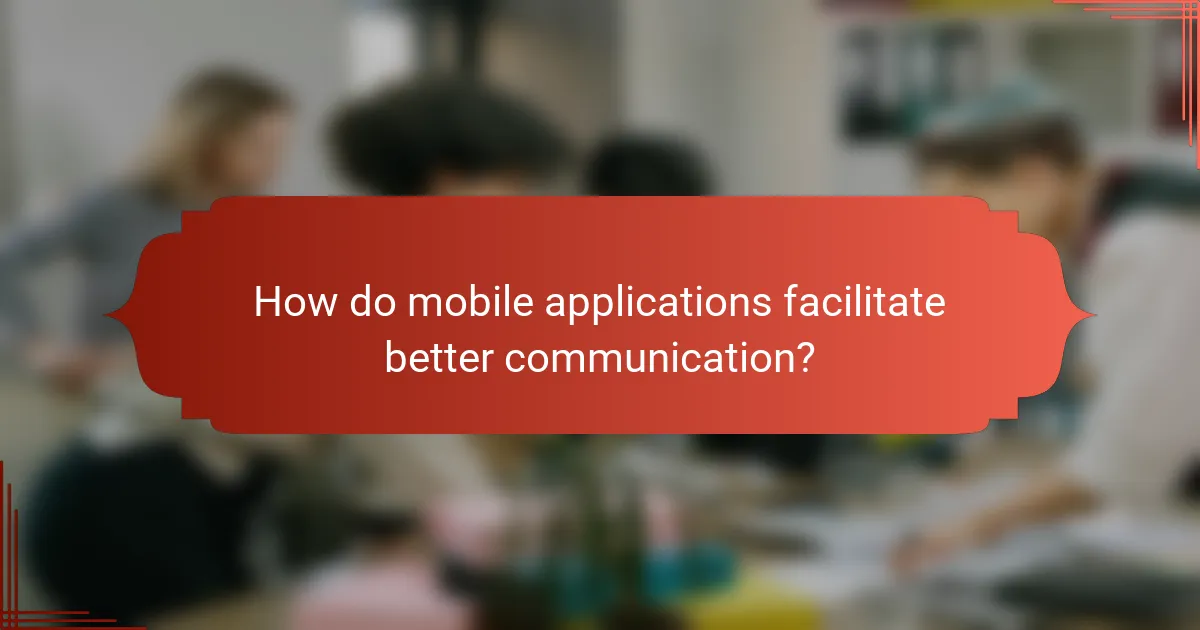
How do mobile applications facilitate better communication?
Mobile applications enhance communication by providing instant access to information and enabling seamless interactions between healthcare providers and patients. These tools streamline processes, reduce delays, and improve overall service outcomes.
Real-time updates
Real-time updates through mobile applications ensure that both patients and healthcare providers have access to the latest information. This can include appointment reminders, changes in treatment plans, or alerts about medication schedules. Such timely notifications help prevent misunderstandings and ensure that everyone is on the same page.
For example, a patient receiving a notification about a last-minute appointment change can adjust their schedule accordingly, reducing the likelihood of missed appointments. Additionally, healthcare teams can communicate urgent updates instantly, improving response times and patient care.
Patient engagement features
Mobile applications often include patient engagement features that encourage active participation in healthcare. These may consist of educational resources, health tracking tools, and secure messaging options that allow patients to communicate directly with their providers. Engaged patients are more likely to adhere to treatment plans and follow preventive measures.
For instance, a health tracking feature might allow patients to log their symptoms or medication intake, which can then be reviewed by their healthcare provider. This interaction fosters a collaborative approach to health management, enhancing the overall quality of care.
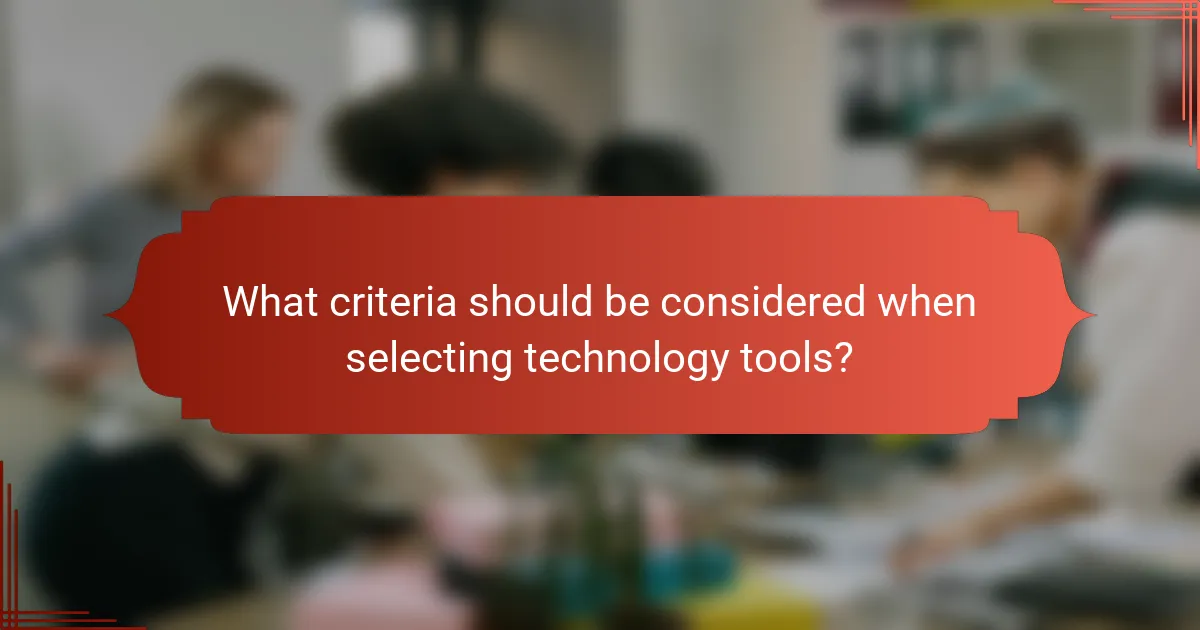
What criteria should be considered when selecting technology tools?
When selecting technology tools for Huguenot service outcomes, consider factors such as cost-effectiveness, user-friendliness, and integration capabilities. These criteria ensure that the tools not only fit within budget constraints but also enhance usability and work seamlessly with existing systems.
Cost-effectiveness
Cost-effectiveness is crucial when evaluating technology tools. Look for solutions that provide a good balance between price and functionality, ensuring that the investment yields significant returns in service outcomes. Consider both initial costs and ongoing expenses, such as maintenance and support.
To assess cost-effectiveness, compare tools based on their features and the value they provide. A tool that costs slightly more but offers better performance or additional features may be more economical in the long run. Utilize trial periods or demos to gauge potential savings before committing.
User-friendliness
User-friendliness is essential to ensure that staff can quickly adapt to new technology tools. A tool that is intuitive and easy to navigate reduces training time and enhances overall productivity. Prioritize solutions that offer clear interfaces and straightforward functionalities.
Gather feedback from potential users during the selection process to identify tools that meet their needs. Consider tools with strong customer support and comprehensive training resources, as these can significantly improve user experience and satisfaction.
Integration capabilities
Integration capabilities determine how well a technology tool can work with existing systems and processes. Choose tools that can easily connect with current software and databases to streamline workflows and data sharing. This reduces redundancy and enhances overall efficiency.
Evaluate the compatibility of potential tools with your existing infrastructure. Look for options that support common standards and protocols, which can simplify integration. A well-integrated tool can lead to significant improvements in service delivery and operational effectiveness.

What are the emerging trends in Huguenot service technologies?
Emerging trends in Huguenot service technologies focus on enhancing efficiency, security, and user experience. Key innovations include artificial intelligence, machine learning, and blockchain, which are reshaping how services are delivered and managed.
AI and machine learning
AI and machine learning are transforming Huguenot services by automating processes and providing data-driven insights. These technologies can analyze large datasets to identify patterns, predict outcomes, and personalize user interactions.
For example, AI can streamline customer support by using chatbots to handle common inquiries, reducing response times to mere seconds. Implementing machine learning algorithms can improve service delivery by optimizing resource allocation based on historical data.
Organizations should consider investing in training staff to work alongside AI tools, ensuring they can leverage these technologies effectively while avoiding over-reliance on automation.
Blockchain for data security
Blockchain technology enhances data security in Huguenot services by providing a decentralized and tamper-proof system for storing information. This approach ensures that sensitive data, such as personal identification or transaction records, is protected from unauthorized access.
For instance, using blockchain can facilitate secure transactions and maintain transparent records, which is crucial for building trust with users. Organizations should evaluate the costs and technical requirements of implementing blockchain solutions, as they can vary significantly.
It’s essential to stay informed about regulatory standards related to data protection, such as GDPR in Europe, to ensure compliance when adopting blockchain technologies.

How can organizations measure the impact of technology on service outcomes?
Organizations can measure the impact of technology on service outcomes by utilizing various assessment tools and metrics that evaluate efficiency, effectiveness, and user satisfaction. Key methods include analyzing data from patient interactions, feedback mechanisms, and performance indicators to gauge improvements in service delivery.
Patient satisfaction surveys
Patient satisfaction surveys are essential tools for measuring how technology affects service outcomes. These surveys typically gather feedback on various aspects of care, including accessibility, communication, and overall experience. By analyzing responses, organizations can identify areas where technology has enhanced or hindered patient satisfaction.
To implement effective patient satisfaction surveys, organizations should focus on clear, concise questions that directly relate to the technological aspects of service delivery. For example, questions might assess the ease of using online appointment systems or the effectiveness of telehealth services. Surveys can be distributed through multiple channels, such as email, SMS, or in-person, to reach a broader audience.
Organizations should also consider benchmarking their survey results against industry standards or similar institutions. This comparison can help identify performance gaps and inform strategic decisions aimed at improving service outcomes through technology. Regularly reviewing and updating survey questions ensures they remain relevant and effective in capturing patient experiences.
